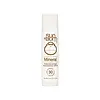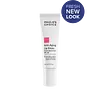What's inside
What's inside
 Key Ingredients
Key Ingredients

 Benefits
Benefits

 Concerns
Concerns

 Ingredients Side-by-side
Ingredients Side-by-side

Zinc Oxide 8%
Cosmetic ColorantPrunus Amygdalus Dulcis Oil
Skin ConditioningSimmondsia Chinensis Seed Oil
EmollientButyrospermum Parkii Butter
Skin ConditioningCera Alba
EmollientEuphorbia Cerifera Wax
Argania Spinosa Kernel Oil
EmollientCaprylic/Capric Triglyceride
MaskingTocopheryl Acetate
AntioxidantCopernicia Cerifera Wax
Tocopherol
AntioxidantGlycine Soja Oil
EmollientGlyceryl Caprylate
EmollientBisabolol
MaskingPolyhydroxystearic Acid
EmulsifyingPolyglyceryl-3 Oleate
EmulsifyingIsostearic Acid
CleansingLecithin
EmollientGlyceryl Undecylenate
EmollientZinc Oxide 8%, Prunus Amygdalus Dulcis Oil, Simmondsia Chinensis Seed Oil, Butyrospermum Parkii Butter, Cera Alba, Euphorbia Cerifera Wax, Argania Spinosa Kernel Oil, Caprylic/Capric Triglyceride, Tocopheryl Acetate, Copernicia Cerifera Wax, Tocopherol, Glycine Soja Oil, Glyceryl Caprylate, Bisabolol, Polyhydroxystearic Acid, Polyglyceryl-3 Oleate, Isostearic Acid, Lecithin, Glyceryl Undecylenate
Homosalate 5%
Skin ConditioningEthylhexyl Salicylate 5%
UV AbsorberButyl Methoxydibenzoylmethane 3%
UV AbsorberOctocrylene 2.5%
UV AbsorberPolybutene
Octyldodecanol
EmollientEthylhexyl Palmitate
EmollientCera Microcristallina
Emulsion StabilisingPolyethylene
AbrasivePolyglyceryl-2 Tetraisostearate
EmollientCocos Nucifera Oil
MaskingAroma
Silica Silylate
EmollientAdenosine
Skin ConditioningRetinyl Palmitate
Skin ConditioningLecithin
EmollientTocopherol
AntioxidantTocopheryl Acetate
AntioxidantIsononyl Isononanoate
EmollientIsopropyl Titanium Triisostearate
EmollientStearalkonium Hectorite
Gel FormingIsopropyl Myristate
EmollientPropylene Carbonate
SolventPolyhydroxystearic Acid
EmulsifyingSilica
AbrasiveCI 15850
Cosmetic ColorantIron Oxides
Titanium Dioxide
Cosmetic ColorantTin Oxide
AbrasiveMica
Cosmetic ColorantPhenoxyethanol
PreservativeCI 77742
Cosmetic ColorantBlue 1 Lake
Cosmetic ColorantCI 15985
Cosmetic ColorantCI 19140
Cosmetic ColorantCI 45380
Cosmetic ColorantCI 73360
Cosmetic ColorantCI 12085
Cosmetic ColorantCI 16035
Cosmetic ColorantHomosalate 5%, Ethylhexyl Salicylate 5%, Butyl Methoxydibenzoylmethane 3%, Octocrylene 2.5%, Polybutene, Octyldodecanol, Ethylhexyl Palmitate, Cera Microcristallina, Polyethylene, Polyglyceryl-2 Tetraisostearate, Cocos Nucifera Oil, Aroma, Silica Silylate, Adenosine, Retinyl Palmitate, Lecithin, Tocopherol, Tocopheryl Acetate, Isononyl Isononanoate, Isopropyl Titanium Triisostearate, Stearalkonium Hectorite, Isopropyl Myristate, Propylene Carbonate, Polyhydroxystearic Acid, Silica, CI 15850, Iron Oxides, Titanium Dioxide, Tin Oxide, Mica, Phenoxyethanol, CI 77742, Blue 1 Lake, CI 15985, CI 19140, CI 45380, CI 73360, CI 12085, CI 16035
 Reviews
Reviews

Ingredients Explained
These ingredients are found in both products.
Ingredients higher up in an ingredient list are typically present in a larger amount.
Lecithin is a term for a group of substances found in the cell membranes of plants, animals, and humans. They are made up of mixture of phospholipids.
This ingredient has emollient and emulsifying properties.
As an emollient, lecithen helps soften the skin and creates a barrier to keep moisture in.
As an emulsifier, it also helps prevent water and oil ingredients from separating. Lecithin can also help ingredients be better absorbed by the skin.
This is because the phospholipids in lecithin produce liposomes. Liposomes help other ingredients get through the skin barrier.
Depending on the source of this ingredient, lecithin may not be fungal acne safe. This is because some sources of lecithin come from soybean oil, which may feed the malassezia yeast that feeds fungal acne.
We recommend reaching out to the brand you are purchasing from to inquire about the source of their lecithin.
Some other names for this ingredient include soy lecithin and deoiled soy lecithin.
Learn more about LecithinPolyhydroxystearic Acid is a soft wax made from castor oil.
It is is a texture thickener, emulsifier, and film-former. Emulsifiers prevent ingredients from separating, such as oils and waters.
Polyhydroxystearic Acid may not be fungal acne safe.
Learn more about Polyhydroxystearic AcidTocopherol (also known as Vitamin E) is a common antioxidant used to help protect the skin from free-radicals and strengthen the skin barrier. It's also fat soluble - this means our skin is great at absorbing it.
Vitamin E also helps keep your natural skin lipids healthy. Your lipid skin barrier naturally consists of lipids, ceramides, and fatty acids. Vitamin E offers extra protection for your skin’s lipid barrier, keeping your skin healthy and nourished.
Another benefit is a bit of UV protection. Vitamin E helps reduce the damage caused by UVB rays. (It should not replace your sunscreen). Combining it with Vitamin C can decrease sunburned cells and hyperpigmentation after UV exposure.
You might have noticed Vitamin E + C often paired together. This is because it is great at stabilizing Vitamin C. Using the two together helps increase the effectiveness of both ingredients.
There are often claims that Vitamin E can reduce/prevent scarring, but these claims haven't been confirmed by scientific research.
Learn more about TocopherolTocopheryl Acetate is AKA Vitamin E. It is an antioxidant and protects your skin from free radicals. Free radicals damage the skin by breaking down collagen.
One study found using Tocopheryl Acetate with Vitamin C decreased the number of sunburned cells.
Tocopheryl Acetate is commonly found in both skincare and dietary supplements.
Learn more about Tocopheryl Acetate